HUI SHAN CAO
•
MARY KRISTIN SAN JUAN GOZUM
•
VENESSA CHAN
•
DEYUAN SUN
•
JIALING LI
•
RUIJUN QI
•
NICOLE BURDYNEWICZ
•
VANESSA PANINGBATAN-CEREZO
Sprout
Question posed: Within the neighbourhood food environment, how can we create alternative design(s) - a combination of place and experience - that connect(s) food security and health to a rich inclusive social experience?
Sprout
Question posed: Within the neighbourhood food environment, how can we create alternative design(s) - a combination of place and experience - that connect(s) food security and health to a rich inclusive social experience?

The site for the main hub was selected as an extension of the Masaryk-Cowan Community Recreation Centre, which is directly next to a park and community garden, but has no formal kitchen. The hub would extend into the park and the space would open onto it in the warmer months. It is also near Queen street, a bustling artery and is near many public amenities like the local health centre, schools, churches, and more parks. The ‘pods’ can be located in groups or as standalone fixtures around the community. They can also be formed to make a greenhouse array, a food festival, or a communal dinner in the park.


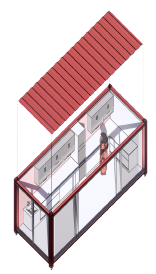
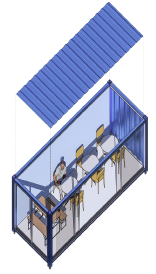
Issues: As real estate and housing costs increase, the Parkdale community and the city at large are having a hard time affording other necessities, especially food. Food insecurity leads to many issues both physical and mental. With this focus of providing more and better food, the aim of this proposal is to build off of the existing community initiatives and give power back to the people of Parkdale. With programs like the food co-op and community fridge shutting down in recent years, it is an increasingly important issue to help the community become more self-sufficient and increase food security as well as food literacy.
Implementation: This proposal includes an addition of a central food hub with a green house, community kitchen, and more flexible community space. This would be developed on publicly held land and therefore be a stable, constant hub. This provides confidence that the services will not disappear. This stability facilitates the development of more ad hoc and spontaneous installations that may border or surpass the bureaucratic control of the city. The design for these ‘seeds’, or ‘pods’, are basic, retrofitted storage containers that serve three basic functions: to produce food, prepare food, and serve food. These pods can be strung together in various configurations to serve a particular space at a particular time. These ‘seeds’ would be dispersed in the community as either a temporary installation, like a food festival, or more permanently where it can grow and evolve as residents use it. An example would be the addition of wood-palette seating or a large creative mural on the side of the ‘pod’. The spaces created between them would facilitate placemaking as the community takes over and nurtures its growth
Implementation: This proposal includes an addition of a central food hub with a green house, community kitchen, and more flexible community space. This would be developed on publicly held land and therefore be a stable, constant hub. This provides confidence that the services will not disappear. This stability facilitates the development of more ad hoc and spontaneous installations that may border or surpass the bureaucratic control of the city. The design for these ‘seeds’, or ‘pods’, are basic, retrofitted storage containers that serve three basic functions: to produce food, prepare food, and serve food. These pods can be strung together in various configurations to serve a particular space at a particular time. These ‘seeds’ would be dispersed in the community as either a temporary installation, like a food festival, or more permanently where it can grow and evolve as residents use it. An example would be the addition of wood-palette seating or a large creative mural on the side of the ‘pod’. The spaces created between them would facilitate placemaking as the community takes over and nurtures its growth
Partnerships: The community could partner up with existing programs in the city, notably Scadding Court, which modifies and sells shipping containers fully outfitted with services and can be customized. People within the Parkdale community could learn and help manufacture them creating a cross-neighbourhood collaboration. Another organization, the Bowery Project, can help provide more, though temporary, growing land with the use of milk crates. They typically take over empty building sites before construction begins, providing fresh produce in the process. Intra-community partnerships would also be imperative, especially with the numerous community gardens, the Parkdale Queen West Community Health Centre, which has a long list of programs, as well as the local schools and churches. The ‘pods’ can be used, developed, and maintained by the community at large to continuously serve the needs of the community.
Barriers: The intervention ‘pods’ are meant to act as temporary or semi-permanent installations that can be shifted around when necessary, either by community need or because of external forces. The ‘seeds’ are a form of tactical urbanism on a large community scale as a sort of protest on the part of the community for the purpose of taking back control of their neighbourhood in the face of gentrification. Rather than formally asking for permission, space for these installations are taken over. It is therefore very useful to be able to move these structures around with little notice. Wheels would be designed into the ‘pods’ so that they could be towed or pushed out of the way when absolutely needed. The pods being storage containers, would also make them durable and lockable.
Barriers: The intervention ‘pods’ are meant to act as temporary or semi-permanent installations that can be shifted around when necessary, either by community need or because of external forces. The ‘seeds’ are a form of tactical urbanism on a large community scale as a sort of protest on the part of the community for the purpose of taking back control of their neighbourhood in the face of gentrification. Rather than formally asking for permission, space for these installations are taken over. It is therefore very useful to be able to move these structures around with little notice. Wheels would be designed into the ‘pods’ so that they could be towed or pushed out of the way when absolutely needed. The pods being storage containers, would also make them durable and lockable.


The chosen target audience is that of immigrant families. As this community continues to function as a landing pad for newcomers, the community already has a number of services catered to them like ESL classes. This proposal aims to help newcomers bond, teach, and learn from existing community members with a focus on food. The idea of the sharing ideas rather than assimilation is a core idea in this design with movable food preparation kitchens where people can cook together, as well as greenhouse pods where food from different countries can be grown, and can pop up right where it is needed most, close to community members. These services are mirrored in the main hub on a larger and more stable scale.
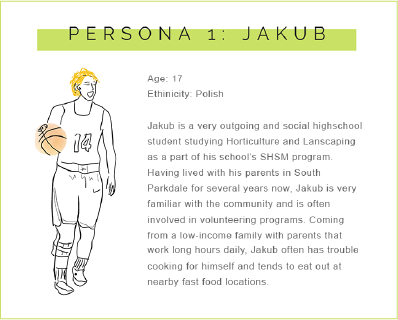


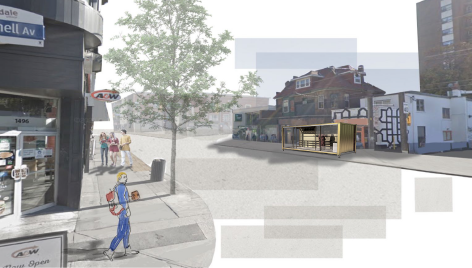
Jakub is often buying his meals from Big Chain Fast Food Restaurants due to its convenience and pricing. He does not pay much attention to the healthy quality of the food he eats, leading to poor food literacy skills. On the way back from A&W, he notices the food pod.

Aaron is new to the neighbourhood and new to his school. However, none of his peers knows that he suffers from some mental health issues due to the food insecurity at home. He is often alone and finds it difficult to connect with his community. When walking his dog Tomato, he notices the these pods along the street.
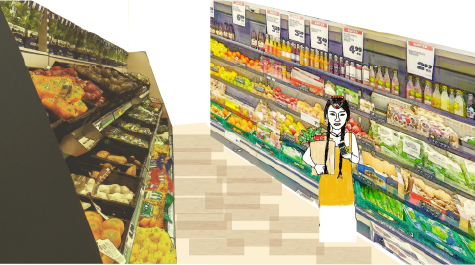
Amala has just settled in Canada with her daughter and husband. She works double shifts but still cannot afford daycare for daughter. Due to her financial food insecurity, she is limited to purchasing discounted goods in a supermarket. She is looking for affordable food to purchase.

Amala learns about the free after school cooking programs offered at the Food Hub where her daughter learns how to cook dishes, garden, and bring home the dishes and fresh ingredients. Amala and her daughter enjoy the free meals and decide to participate in the upcoming Multicultural Food Festival. In preparation, Amala spends some time helping in the garden.
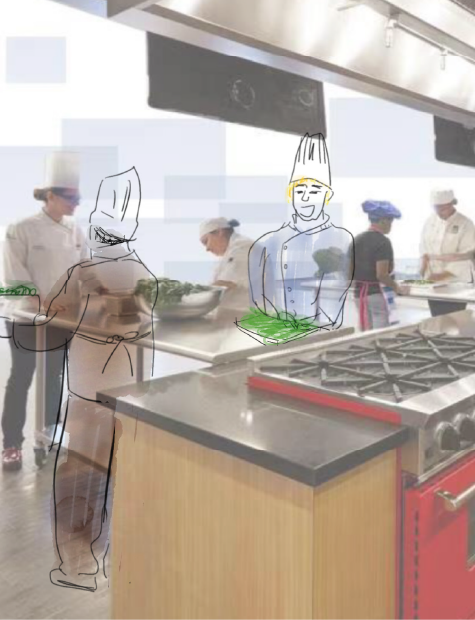
Jakub and Aaron approach the food pods and learn about all the various cooking opportunities in the neighbourhood. They both decide to participate and learn new cooking skills. Jakub is learning how to cook his own healthier dishes, and Aaron made a new friend. Both of the boys are starting to overcome their food insecurities.
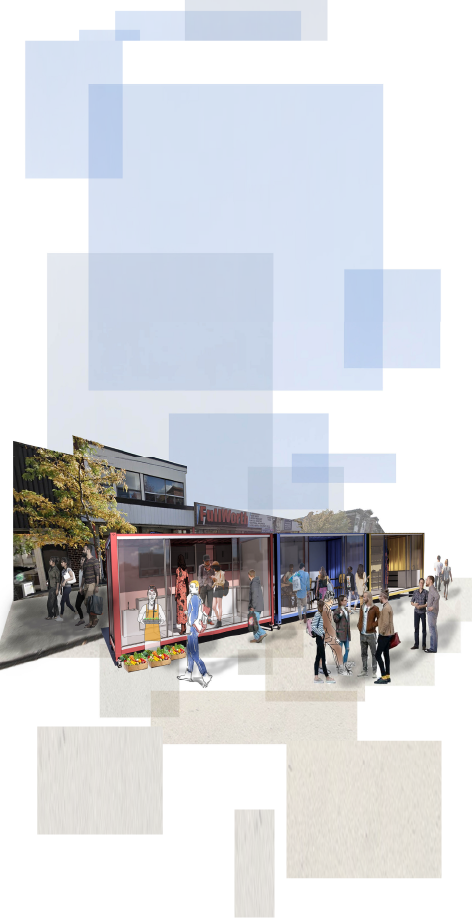
Jakub, Aaron, and Amala attend the Multicultural Day Festival. Jakub participates as a volunteer, learning about all the new dishes he can make! Aaron is connecting with his community members through food. Amala was able to use the free produce to create dishes to sell at the event. They are starting to overcome their food insecurities and learn about the existing programs in their community.